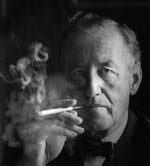Exhibition: For Your Eyes Only
This is the year of James Bond. We visit two exhibitions showing the reality, fantasy and imagery of 007’s world


Moscow, 1955. SMERSH, the Soviet government s murder squad, wants to strike at the heart of the British Secret Service. Have they no one who is a hero to the organisation? asks the head of SMERSH. Myths are built on heroic deeds and heroic people. Have they no such men? Readers of From Russia with Love, the fifth book in what was becoming an increasingly popular series, knew exactly the man. And, more than 50 years later, after the films of Connery, Craig et al have made the Double-0 agent a global icon, one can t help but hear John Barry s theme swell to accompany the punchline: There is a man called Bond.
But behind Bond, there was a man called Ian Fleming. This year sees two new exhibitions marking the centenary of his birth. One unravels the real deeds and people that led to the creation of James Bond, and the other looks at the changing face of the Bond book covers. Three wars shaped Fleming, so it s fitting that the Imperial War Museum hosts the story of 007 s genesis. The exhibition opens with the wooden cross that marked the grave of Fleming s father, who was killed in the First World War when his son was eight.
Ian Fleming grew up in the shadow of his older brother. After a scandal with a prostitute at Sandhurst, he flitted from journalism to banking. The Second World War saved him from a life indulging in the typical Bond pursuits of philandering and gambling. Unlike his fictional alter ego, Fleming saw out the war from behind a desk, as assistant to Admiral John Godfrey director of naval intelligence, a surrogate father figure, and prototype for Bond s boss, M. Deep within the Admiralty s nerve-centre, Fleming planned raids and operations with the same meticulous detail that he would bring to his thrillers.
But the world was a different place in 1952 when he sat down in his Jamaican retreat to write the spy story to end all spy stories . Gone were the Red Indian days of the Second World War. Instead, the cloak-and-dagger world of the Cold War looms large over the series. Actual accounts of defections and assassinations inspired several Bond plots. Sometimes Fleming even appeared to forecast events: Thunderball s threat of nuclear attack on Miami anticipated the Cuban missile crisis of two years later.
However, the politics wasn t the real appeal of Fleming s novels. We re the only two writers, he confided to Somerset Maugham, who write about what people are really interested in: cards, money, gold and things like that. He was being kind to Maugham nobody does it better than Fleming. His con-noisseur s account of Bond s drink of choice puts the cinematic shaken not stirred version to shame: A dry martini. In a deep Champagne goblet. Three measures of Gordon s, one of vodka, half a measure of Kina Lillet. Shake it well until it s ice cold, then add a thin slice of lemon peel.
Fleming was clear about his target audience warm-blooded heterosexuals in railways, airplanes or beds . For a 1950s Britain, in the grip of rationing, aware of its diminishing role on the world stage, and with the sexual licence of the 1960s not yet on the horizon, the Bond books were escapist fantasies of exotic food, locations, thrills and women.
The adventures that lay in store were heralded loud and clear on the front of the books. The exhibition of Bond covers at The Fleming Collection contains not a few sultry female eyes and smoking guns. But there are oddities. Fleming s design for Casino Royale is surprisingly chaste, and Dick Bruna, creator of the children s cartoon rabbit Miffy, did some covers for the Dutch editions.
Exquisite houses, the beauty of Nature, and how to get the most from your life, straight to your inbox.
As crystallised in the artwork, the allure of 007 lies in Fleming s merging of the shadowy world of spying with the decadent life of the rich. Fleming took care to ensure that Bond remained a cipher throughout, yet his own life proves a fascinating key with which to decode his hero.
For Your Eyes Only: Ian Fleming and James Bond is at the Imperial War Museum, London SE1, April 17 March 1, 2009 (020 7416 5320; www.iwm.org.uk). Bond Bound: Ian Fleming and the Art of Cover Design is at The Fleming Collection, London W1, April 22 June 28 (020 7409 5730; www.flemingcollection.co.uk)
Country Life is unlike any other magazine: the only glossy weekly on the newsstand and the only magazine that has been guest-edited by His Majesty The King not once, but twice. It is a celebration of modern rural life and all its diverse joys and pleasures — that was first published in Queen Victoria's Diamond Jubilee year. Our eclectic mixture of witty and informative content — from the most up-to-date property news and commentary and a coveted glimpse inside some of the UK's best houses and gardens, to gardening, the arts and interior design, written by experts in their field — still cannot be found in print or online, anywhere else.
